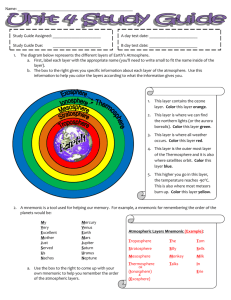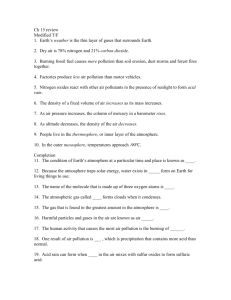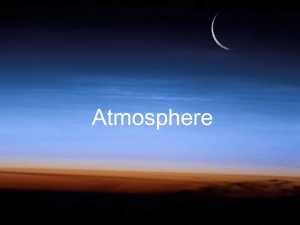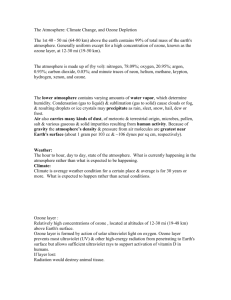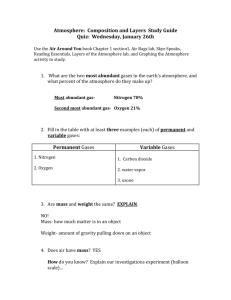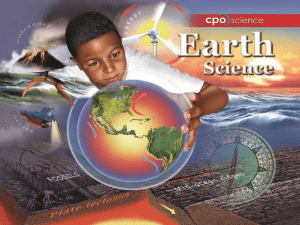Earth's Atmosphere: Layers, Ozone, and Greenhouse Effect
advertisement
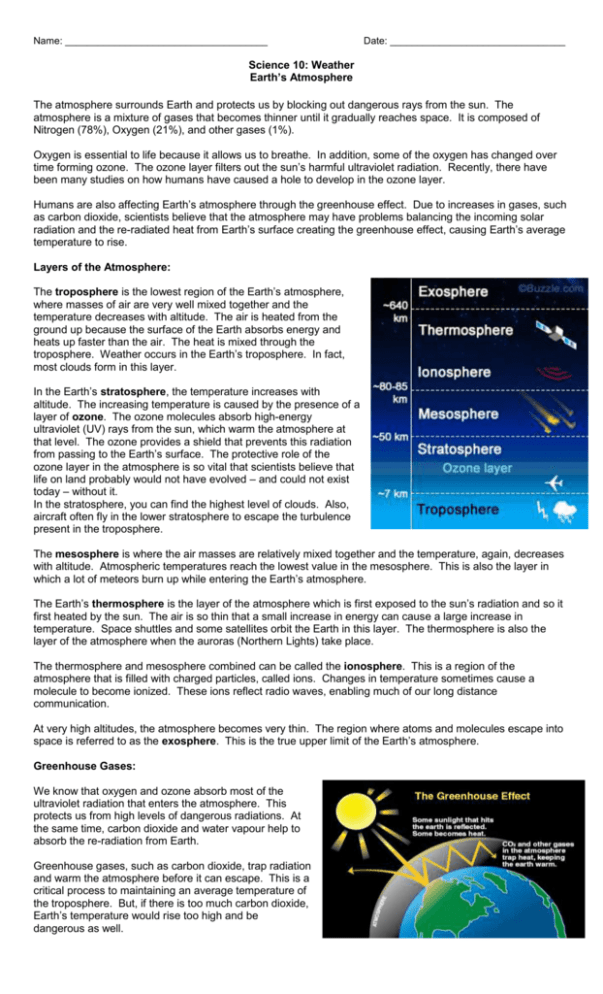
Name: _____________________________________ Date: ________________________________ Science 10: Weather Earth’s Atmosphere The atmosphere surrounds Earth and protects us by blocking out dangerous rays from the sun. The atmosphere is a mixture of gases that becomes thinner until it gradually reaches space. It is composed of Nitrogen (78%), Oxygen (21%), and other gases (1%). Oxygen is essential to life because it allows us to breathe. In addition, some of the oxygen has changed over time forming ozone. The ozone layer filters out the sun’s harmful ultraviolet radiation. Recently, there have been many studies on how humans have caused a hole to develop in the ozone layer. Humans are also affecting Earth’s atmosphere through the greenhouse effect. Due to increases in gases, such as carbon dioxide, scientists believe that the atmosphere may have problems balancing the incoming solar radiation and the re-radiated heat from Earth’s surface creating the greenhouse effect, causing Earth’s average temperature to rise. Layers of the Atmosphere: The troposphere is the lowest region of the Earth’s atmosphere, where masses of air are very well mixed together and the temperature decreases with altitude. The air is heated from the ground up because the surface of the Earth absorbs energy and heats up faster than the air. The heat is mixed through the troposphere. Weather occurs in the Earth’s troposphere. In fact, most clouds form in this layer. In the Earth’s stratosphere, the temperature increases with altitude. The increasing temperature is caused by the presence of a layer of ozone. The ozone molecules absorb high-energy ultraviolet (UV) rays from the sun, which warm the atmosphere at that level. The ozone provides a shield that prevents this radiation from passing to the Earth’s surface. The protective role of the ozone layer in the atmosphere is so vital that scientists believe that life on land probably would not have evolved – and could not exist today – without it. In the stratosphere, you can find the highest level of clouds. Also, aircraft often fly in the lower stratosphere to escape the turbulence present in the troposphere. The mesosphere is where the air masses are relatively mixed together and the temperature, again, decreases with altitude. Atmospheric temperatures reach the lowest value in the mesosphere. This is also the layer in which a lot of meteors burn up while entering the Earth’s atmosphere. The Earth’s thermosphere is the layer of the atmosphere which is first exposed to the sun’s radiation and so it first heated by the sun. The air is so thin that a small increase in energy can cause a large increase in temperature. Space shuttles and some satellites orbit the Earth in this layer. The thermosphere is also the layer of the atmosphere when the auroras (Northern Lights) take place. The thermosphere and mesosphere combined can be called the ionosphere. This is a region of the atmosphere that is filled with charged particles, called ions. Changes in temperature sometimes cause a molecule to become ionized. These ions reflect radio waves, enabling much of our long distance communication. At very high altitudes, the atmosphere becomes very thin. The region where atoms and molecules escape into space is referred to as the exosphere. This is the true upper limit of the Earth’s atmosphere. Greenhouse Gases: We know that oxygen and ozone absorb most of the ultraviolet radiation that enters the atmosphere. This protects us from high levels of dangerous radiations. At the same time, carbon dioxide and water vapour help to absorb the re-radiation from Earth. Greenhouse gases, such as carbon dioxide, trap radiation and warm the atmosphere before it can escape. This is a critical process to maintaining an average temperature of the troposphere. But, if there is too much carbon dioxide, Earth’s temperature would rise too high and be dangerous as well. Name: _____________________________________ Date: ________________________________ Science 10: Weather Earth’s Atmosphere Read the background information. Complete the table and answer the following questions. Atmospheric Layer Important Characteristics of the Layer Troposphere Stratosphere Mesosphere Thermosphere Ionosphere Exosphere 1. List three things the atmosphere does for us. 2. What important layer exists within the stratosphere? Why is it important? 3. What do you think will happen to Earth if the hole in the ozone increases? 4. Why are greenhouse gases good for Earth? 5. Fossil fuels are the remains of living organisms, in the form of coal or gas. When fossil fuels are burned, they release an excess of carbon dioxide. Why does the increased burning of fossil fuels, by humans, have a potentially dangerous impact on Earth? Name: _____________________________________ Date: ________________________________ Science 10: Weather Earth’s Atmosphere Answers Atmospheric Layer Important Characteristics of the Layer Troposphere Air is heated from the ground Weather occurs here Stratosphere Contains ozone layer Airplane fly here Meteors burn up here Thermosphere Exposes to sun’s rays Auroras take place here Ionosphere Mesosphere and Thermosphere Ions help reflect radio waves Exosphere Upper limit Atoms escape into space Mesosphere 1. List three things the atmosphere does for us. Supplies oxygen Protects us from meteors Protects us from harmful rays Maintains temperature necessary for life 2. What important layer exists within the stratosphere? Why is it important? Ozone layer Absorbs UV rays, acts as a shield 3. What do you think will happen to Earth if the hole in the ozone increases? Earth will start to receive UV rays Harmful to plants and animals 4. Why are greenhouse gases good for Earth? Keep Earth’s temperatures warm enough for life 5. Fossil fuels are the remains of living organisms, in the form of coal or gas. When fossil fuels are burned, they release an excess of carbon dioxide. Why does the increased burning of fossil fuels, by humans, have a potentially dangerous impact on Earth? More CO2 will cause more heat trapped, increase temperatures of Earth, cause problems for life

